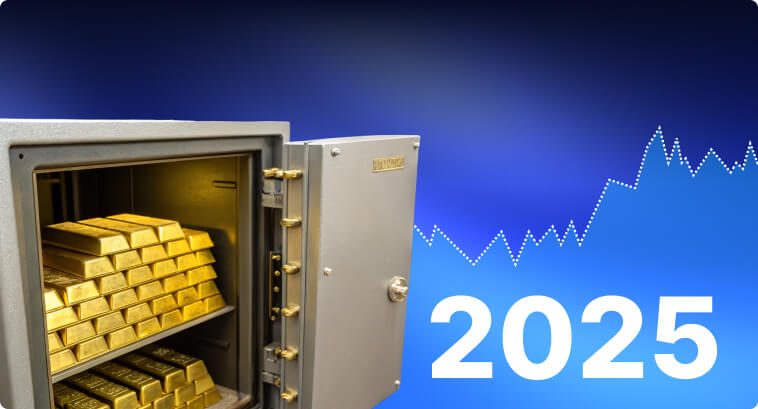Gold Market in 2025: Expert Forecasts, Investment Strategies, and Top Gold ETFs


Volatility in the gold market remains high amidst geopolitical tensions. We consulted experts to find out what to expect from gold in 2025 and which investment instruments are most relevant for this asset.
In 2024, the price of gold reached a historic high, surpassing $2,800 per ounce. Gold prices broke records throughout the year due to its appeal as a safe-haven asset, extensive purchases by central banks, and widespread geopolitical uncertainty.
According to the World Gold Council, in October, central banks worldwide purchased a total of 60 tons of gold—the highest monthly volume this year.
For half a century, gold has shown an inverse correlation with U.S. interest rates.
On December 18, the Federal Reserve cut the interest rate to 4.5%.
Federal Reserve Chair Jerome Powell stated that steady economic growth, a strong labor market, and persistent inflation require a cautious approach to rate cuts. According to CME FedWatch data, the likelihood of further easing of monetary policy in the U.S. in January is estimated at 6.9%.
The next rate decision is scheduled for January 29.
With the Fed reducing rates, the appeal of U.S. bonds diminishes, driving increased investor interest in gold.

Beyond the Federal Reserve, central bank purchases of gold for reserves significantly impact the precious metals market. In 2024, China set a historic record for gold purchases, joined by India, which even reduced its import duties on gold.
According to the World Gold Council, the Reserve Bank of India led global gold purchases both on an annual basis and for the month of October. India acquired 27 tons of gold in October, bringing its annual total to 77 tons—a fivefold increase compared to 2023.
The second-largest buyer was Turkey’s central bank (17 tons in October), followed by Poland’s central bank (8 tons). Together, these three central banks accounted for 60% of global gold purchases in October.
Russia also followed the trend. According to its central bank, the country’s gold reserves exceeded $200 billion for the first time. Additionally, the share of gold in Russia’s foreign reserves reached a 25-year high at 32.9%, the highest level since December 1, 1999, when it stood at 33.95%.
Stable demand from central banks supported gold prices throughout 2024. Most global regulators began cautiously lowering interest rates in September amidst signs of slowing inflation, pushing gold prices to historical highs.
When prices rise, national currencies lose value as their purchasing power declines. Under such conditions, gold serves as a “safe haven.” Unlike fiat currencies, which can be printed in unlimited quantities, gold supplies are limited, and mining it is both challenging and constrained. This helps gold maintain its value during economic instability and inflationary periods.
A prime example is the 2008 financial crisis, when central banks began mass printing money to stimulate the economy. During this time, gold prices surged from $800 to $1,900 per ounce as investors sought protection against potential inflation. This pattern repeated during the COVID-19 pandemic, and the current record-breaking rally is no exception.
Gold is considered a reliable hedge against inflation, traditionally appreciating during inflationary periods and acting as a defensive asset.
The sharp rise in gold prices this year suggests a potential correction. However, this could offer investors an opportunity to enter the market at more favorable prices. Overall, analysts predict gold prices could reach $3,000 per ounce in 2025.
Many experts share the views of Goldman Sachs and UBS, which also forecast a rise in gold prices to $3,000 per ounce in 2025.
A potential driver for gold’s growth in 2025 could be Donald Trump’s policies, known for their unpredictable and aggressive style. Trump’s previous term was marked by exceptional market volatility, which often influences the prices of precious metals, particularly gold.
Peter Schiff, Chief Market Analyst at Euro Pacific Asset Management, believes that gold prices could double or triple in the next decade.
Our experts suggest that sustained demand from central banks and the jewelry industry, combined with growing interest in gold ETFs, could support continued price growth for the precious metal, potentially exceeding current levels.
The sharp rise in gold prices last year suggests a potential correction. However, this could offer investors an opportunity to enter the market at more favorable prices. In general, gold prices in 2025 are expected to reach around $3,000 per ounce.

SabioTrade analyzed expert opinions and compiled three investment options available for gold investors.
Investing directly in physical gold is considered one of the most conservative and safest methods. This could include gold bars, investment-grade coins, or even commemorative coins.
For investors with a higher risk tolerance, experts recommend investing in shares of gold mining companies.
Investing in gold mining company stocks offers indirect exposure to gold, as prices depend not only on the metal’s value but also on factors such as a company’s financial and operational performance, corporate governance, and capital allocation.
The most profitable gold miner ETF, based on performance over the past year, is the Sprott Gold Miners ETF (SGDM). Below, we review the three top gold miner ETFs.
To focus on the investment strategies of the funds, the list of largest assets for each ETF excludes cash and assets acquired through securities lending proceeds unless unusual circumstances arise, such as when the cash portion is exceptionally large.
Performance:
SGDM tracks the Solactive Gold Miners Custom Factors Index, which includes major gold mining companies listed on Canadian and leading U.S. exchanges. The index focuses primarily on companies with the highest revenue growth, free cash flow yield, and low long-term debt-to-equity ratios. Approximately 71.3% of SGDM’s holdings are based in Canada, with most of the remainder in the U.S. A small portion of the portfolio includes companies headquartered in South Africa, the U.K., and Australia.
The largest assets in SGDM include:
Performance:
The GDX aims to track the NYSE Arca Gold Miners Index, which consists of companies involved in the gold mining industry. This multi-cap fund is one of the most popular ETFs of its kind, offering significant liquidity advantages over other similar funds. Nearly 42% of the fund’s portfolio comprises shares of Canadian companies, with the U.S. and Australia ranking second and third, respectively. GDX also holds companies based in Brazil, South Africa, China, and several other countries.
The top ten holdings make up just over 62% of GDX’s portfolio. Its three largest assets include:
Performance:
GOAU tracks the U.S. Global GO Gold and Precious Metal Miners Index, which consists of companies involved in precious metal mining through either active production or passive means, such as royalty ownership or production streams.
GOAU is a multi-cap fund focused on growth and value stocks in developed markets. It has a highly concentrated portfolio, with the top ten holdings accounting for more than 59% of invested assets.
The largest assets in GOAU include: